Management and Operation of M&S: Roles, Theories, and Practices
VerifiedAdded on 2020/07/22
|11
|3653
|613
Report
AI Summary
This report delves into the management and operation of Marks & Spencer (M&S), examining the distinct roles and characteristics of leaders and managers. It explores the functions of leaders in various situations, with specific references to M&S, and discusses different leadership theories, including systematic leadership. The report investigates key approaches to operations management within M&S, emphasizing their importance in achieving business objectives. It also considers the impact of the business environment on operational management and decision-making by M&S leaders and managers. The analysis covers managerial responsibilities such as planning, organizing, staffing, and leading, as well as the application of systematic approaches in organizational planning and the integration of personal and organizational goals. The report provides insights into how M&S leaders and managers navigate their roles to drive organizational success.
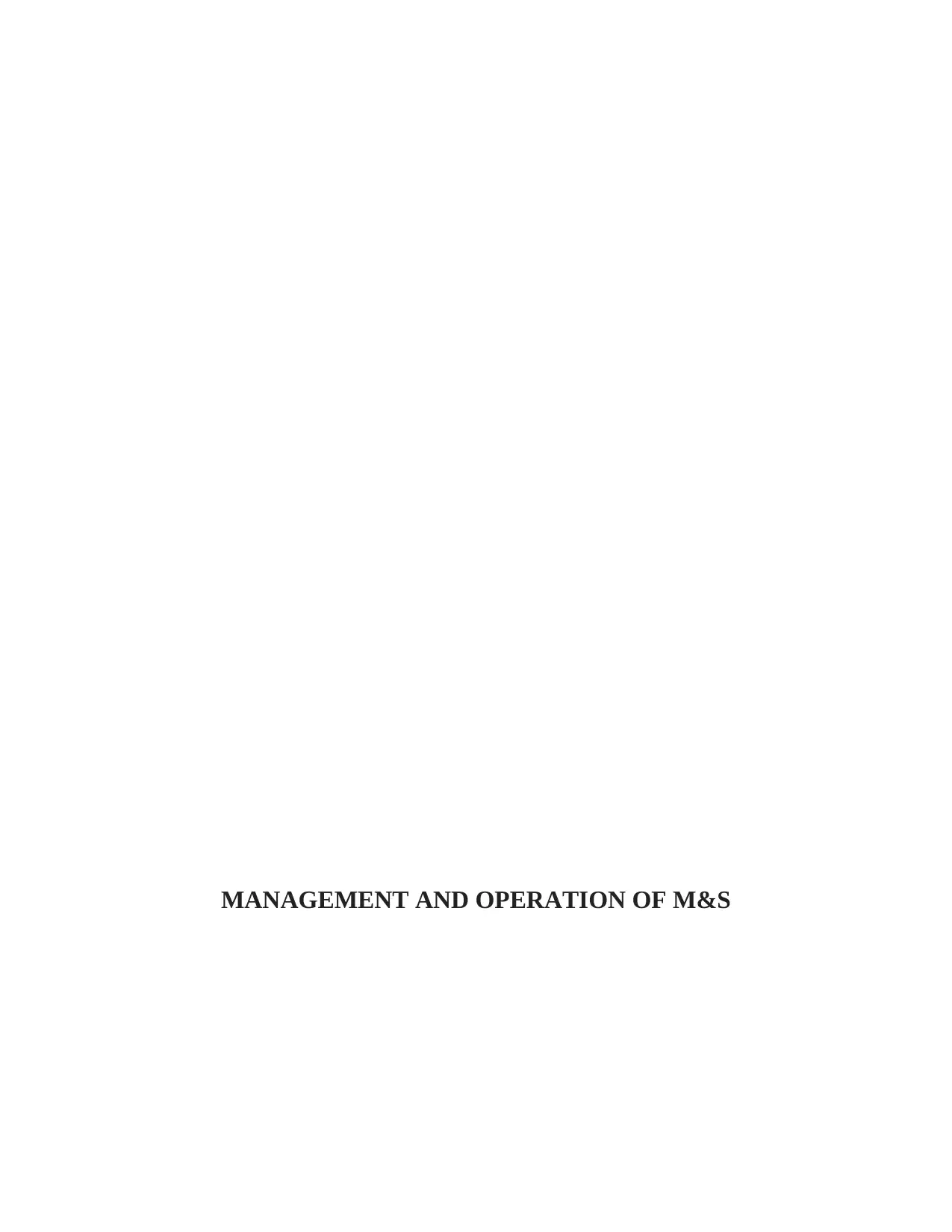
MANAGEMENT AND OPERATION OF M&S
Paraphrase This Document
Need a fresh take? Get an instant paraphrase of this document with our AI Paraphraser
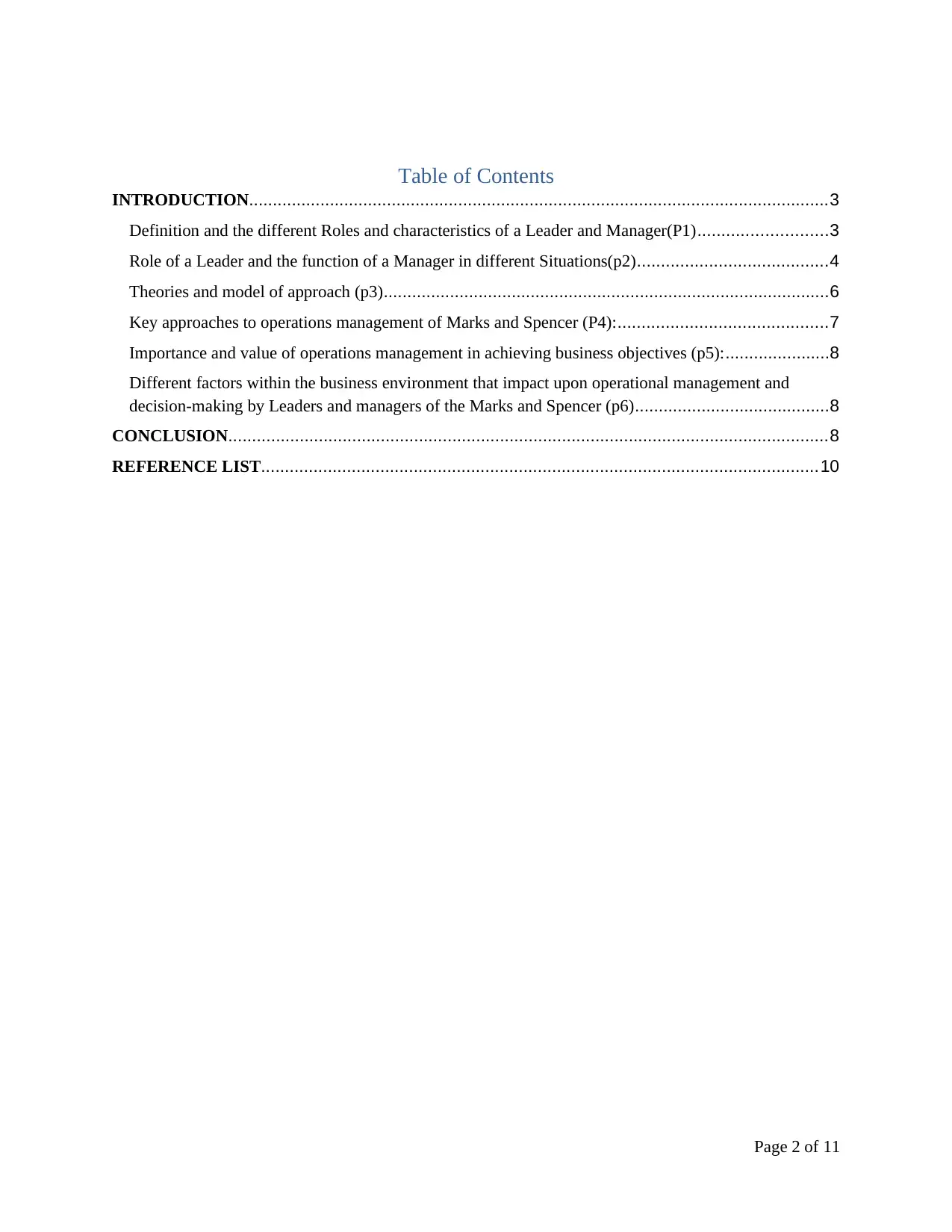
Table of Contents
INTRODUCTION..........................................................................................................................3
Definition and the different Roles and characteristics of a Leader and Manager(P1)...........................3
Role of a Leader and the function of a Manager in different Situations(p2)........................................4
Theories and model of approach (p3)..............................................................................................6
Key approaches to operations management of Marks and Spencer (P4):............................................7
Importance and value of operations management in achieving business objectives (p5):......................8
Different factors within the business environment that impact upon operational management and
decision-making by Leaders and managers of the Marks and Spencer (p6).........................................8
CONCLUSION..............................................................................................................................8
REFERENCE LIST.....................................................................................................................10
Page 2 of 11
INTRODUCTION..........................................................................................................................3
Definition and the different Roles and characteristics of a Leader and Manager(P1)...........................3
Role of a Leader and the function of a Manager in different Situations(p2)........................................4
Theories and model of approach (p3)..............................................................................................6
Key approaches to operations management of Marks and Spencer (P4):............................................7
Importance and value of operations management in achieving business objectives (p5):......................8
Different factors within the business environment that impact upon operational management and
decision-making by Leaders and managers of the Marks and Spencer (p6).........................................8
CONCLUSION..............................................................................................................................8
REFERENCE LIST.....................................................................................................................10
Page 2 of 11
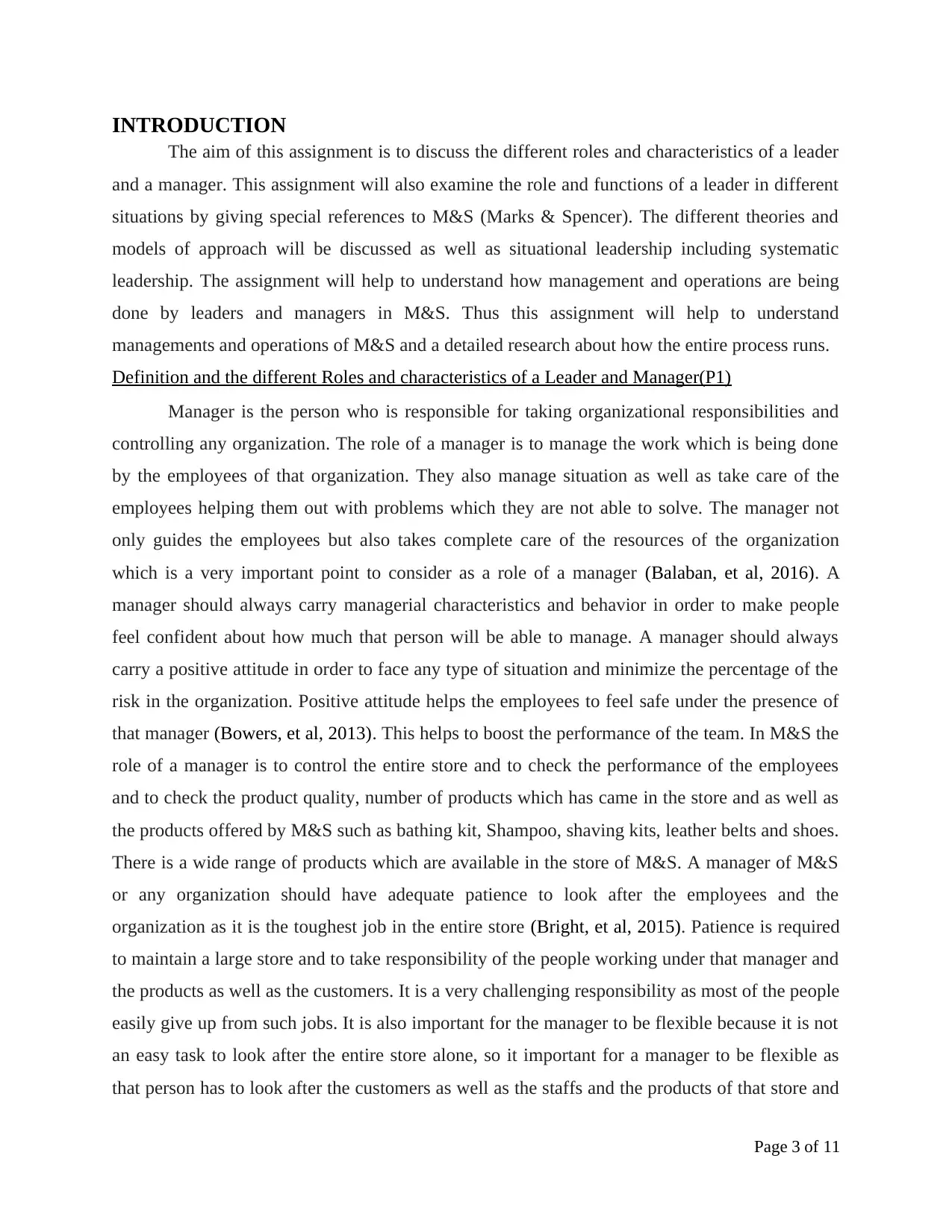
INTRODUCTION
The aim of this assignment is to discuss the different roles and characteristics of a leader
and a manager. This assignment will also examine the role and functions of a leader in different
situations by giving special references to M&S (Marks & Spencer). The different theories and
models of approach will be discussed as well as situational leadership including systematic
leadership. The assignment will help to understand how management and operations are being
done by leaders and managers in M&S. Thus this assignment will help to understand
managements and operations of M&S and a detailed research about how the entire process runs.
Definition and the different Roles and characteristics of a Leader and Manager(P1)
Manager is the person who is responsible for taking organizational responsibilities and
controlling any organization. The role of a manager is to manage the work which is being done
by the employees of that organization. They also manage situation as well as take care of the
employees helping them out with problems which they are not able to solve. The manager not
only guides the employees but also takes complete care of the resources of the organization
which is a very important point to consider as a role of a manager (Balaban, et al, 2016). A
manager should always carry managerial characteristics and behavior in order to make people
feel confident about how much that person will be able to manage. A manager should always
carry a positive attitude in order to face any type of situation and minimize the percentage of the
risk in the organization. Positive attitude helps the employees to feel safe under the presence of
that manager (Bowers, et al, 2013). This helps to boost the performance of the team. In M&S the
role of a manager is to control the entire store and to check the performance of the employees
and to check the product quality, number of products which has came in the store and as well as
the products offered by M&S such as bathing kit, Shampoo, shaving kits, leather belts and shoes.
There is a wide range of products which are available in the store of M&S. A manager of M&S
or any organization should have adequate patience to look after the employees and the
organization as it is the toughest job in the entire store (Bright, et al, 2015). Patience is required
to maintain a large store and to take responsibility of the people working under that manager and
the products as well as the customers. It is a very challenging responsibility as most of the people
easily give up from such jobs. It is also important for the manager to be flexible because it is not
an easy task to look after the entire store alone, so it important for a manager to be flexible as
that person has to look after the customers as well as the staffs and the products of that store and
Page 3 of 11
The aim of this assignment is to discuss the different roles and characteristics of a leader
and a manager. This assignment will also examine the role and functions of a leader in different
situations by giving special references to M&S (Marks & Spencer). The different theories and
models of approach will be discussed as well as situational leadership including systematic
leadership. The assignment will help to understand how management and operations are being
done by leaders and managers in M&S. Thus this assignment will help to understand
managements and operations of M&S and a detailed research about how the entire process runs.
Definition and the different Roles and characteristics of a Leader and Manager(P1)
Manager is the person who is responsible for taking organizational responsibilities and
controlling any organization. The role of a manager is to manage the work which is being done
by the employees of that organization. They also manage situation as well as take care of the
employees helping them out with problems which they are not able to solve. The manager not
only guides the employees but also takes complete care of the resources of the organization
which is a very important point to consider as a role of a manager (Balaban, et al, 2016). A
manager should always carry managerial characteristics and behavior in order to make people
feel confident about how much that person will be able to manage. A manager should always
carry a positive attitude in order to face any type of situation and minimize the percentage of the
risk in the organization. Positive attitude helps the employees to feel safe under the presence of
that manager (Bowers, et al, 2013). This helps to boost the performance of the team. In M&S the
role of a manager is to control the entire store and to check the performance of the employees
and to check the product quality, number of products which has came in the store and as well as
the products offered by M&S such as bathing kit, Shampoo, shaving kits, leather belts and shoes.
There is a wide range of products which are available in the store of M&S. A manager of M&S
or any organization should have adequate patience to look after the employees and the
organization as it is the toughest job in the entire store (Bright, et al, 2015). Patience is required
to maintain a large store and to take responsibility of the people working under that manager and
the products as well as the customers. It is a very challenging responsibility as most of the people
easily give up from such jobs. It is also important for the manager to be flexible because it is not
an easy task to look after the entire store alone, so it important for a manager to be flexible as
that person has to look after the customers as well as the staffs and the products of that store and
Page 3 of 11
⊘ This is a preview!⊘
Do you want full access?
Subscribe today to unlock all pages.

Trusted by 1+ million students worldwide
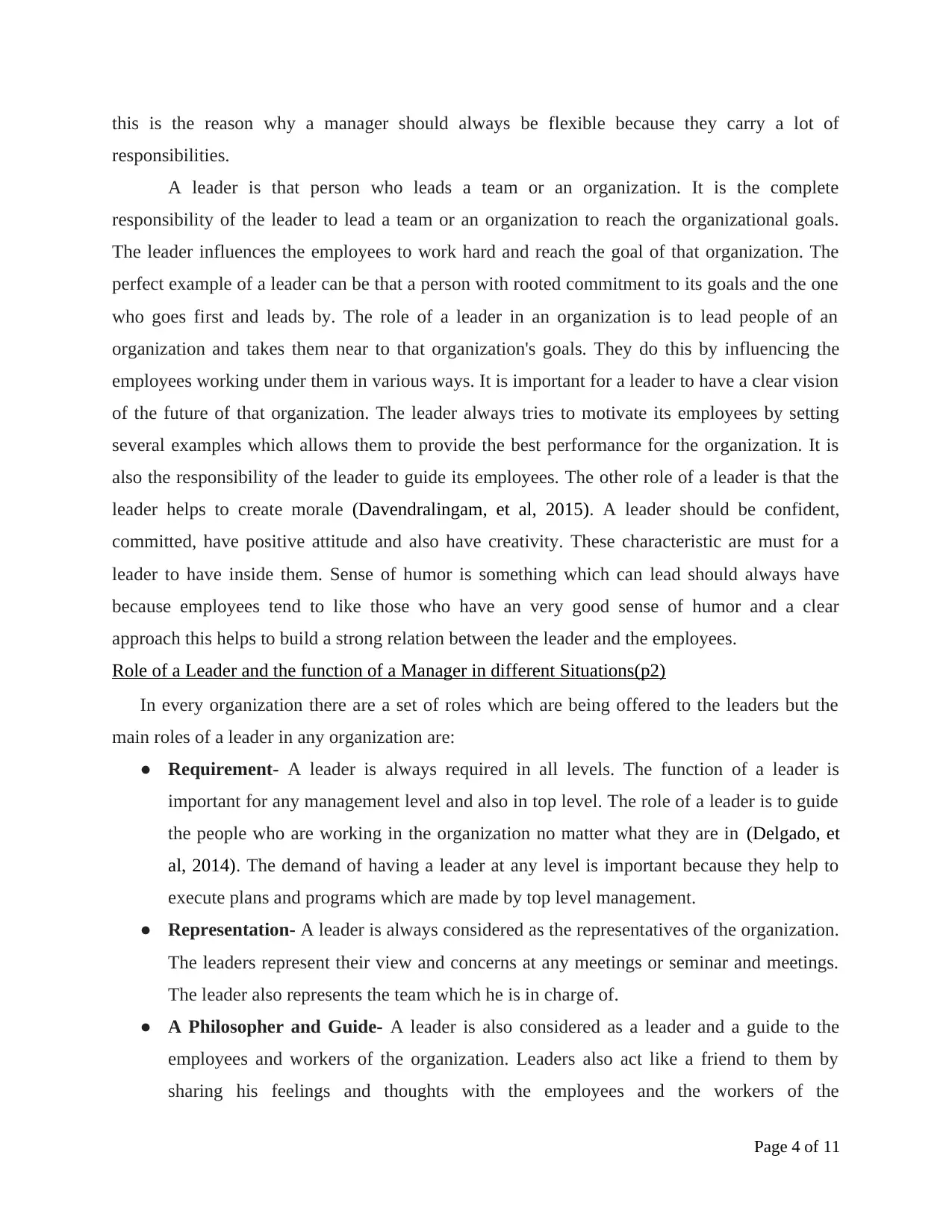
this is the reason why a manager should always be flexible because they carry a lot of
responsibilities.
A leader is that person who leads a team or an organization. It is the complete
responsibility of the leader to lead a team or an organization to reach the organizational goals.
The leader influences the employees to work hard and reach the goal of that organization. The
perfect example of a leader can be that a person with rooted commitment to its goals and the one
who goes first and leads by. The role of a leader in an organization is to lead people of an
organization and takes them near to that organization's goals. They do this by influencing the
employees working under them in various ways. It is important for a leader to have a clear vision
of the future of that organization. The leader always tries to motivate its employees by setting
several examples which allows them to provide the best performance for the organization. It is
also the responsibility of the leader to guide its employees. The other role of a leader is that the
leader helps to create morale (Davendralingam, et al, 2015). A leader should be confident,
committed, have positive attitude and also have creativity. These characteristic are must for a
leader to have inside them. Sense of humor is something which can lead should always have
because employees tend to like those who have an very good sense of humor and a clear
approach this helps to build a strong relation between the leader and the employees.
Role of a Leader and the function of a Manager in different Situations(p2)
In every organization there are a set of roles which are being offered to the leaders but the
main roles of a leader in any organization are:
● Requirement- A leader is always required in all levels. The function of a leader is
important for any management level and also in top level. The role of a leader is to guide
the people who are working in the organization no matter what they are in (Delgado, et
al, 2014). The demand of having a leader at any level is important because they help to
execute plans and programs which are made by top level management.
● Representation- A leader is always considered as the representatives of the organization.
The leaders represent their view and concerns at any meetings or seminar and meetings.
The leader also represents the team which he is in charge of.
● A Philosopher and Guide- A leader is also considered as a leader and a guide to the
employees and workers of the organization. Leaders also act like a friend to them by
sharing his feelings and thoughts with the employees and the workers of the
Page 4 of 11
responsibilities.
A leader is that person who leads a team or an organization. It is the complete
responsibility of the leader to lead a team or an organization to reach the organizational goals.
The leader influences the employees to work hard and reach the goal of that organization. The
perfect example of a leader can be that a person with rooted commitment to its goals and the one
who goes first and leads by. The role of a leader in an organization is to lead people of an
organization and takes them near to that organization's goals. They do this by influencing the
employees working under them in various ways. It is important for a leader to have a clear vision
of the future of that organization. The leader always tries to motivate its employees by setting
several examples which allows them to provide the best performance for the organization. It is
also the responsibility of the leader to guide its employees. The other role of a leader is that the
leader helps to create morale (Davendralingam, et al, 2015). A leader should be confident,
committed, have positive attitude and also have creativity. These characteristic are must for a
leader to have inside them. Sense of humor is something which can lead should always have
because employees tend to like those who have an very good sense of humor and a clear
approach this helps to build a strong relation between the leader and the employees.
Role of a Leader and the function of a Manager in different Situations(p2)
In every organization there are a set of roles which are being offered to the leaders but the
main roles of a leader in any organization are:
● Requirement- A leader is always required in all levels. The function of a leader is
important for any management level and also in top level. The role of a leader is to guide
the people who are working in the organization no matter what they are in (Delgado, et
al, 2014). The demand of having a leader at any level is important because they help to
execute plans and programs which are made by top level management.
● Representation- A leader is always considered as the representatives of the organization.
The leaders represent their view and concerns at any meetings or seminar and meetings.
The leader also represents the team which he is in charge of.
● A Philosopher and Guide- A leader is also considered as a leader and a guide to the
employees and workers of the organization. Leaders also act like a friend to them by
sharing his feelings and thoughts with the employees and the workers of the
Page 4 of 11
Paraphrase This Document
Need a fresh take? Get an instant paraphrase of this document with our AI Paraphraser
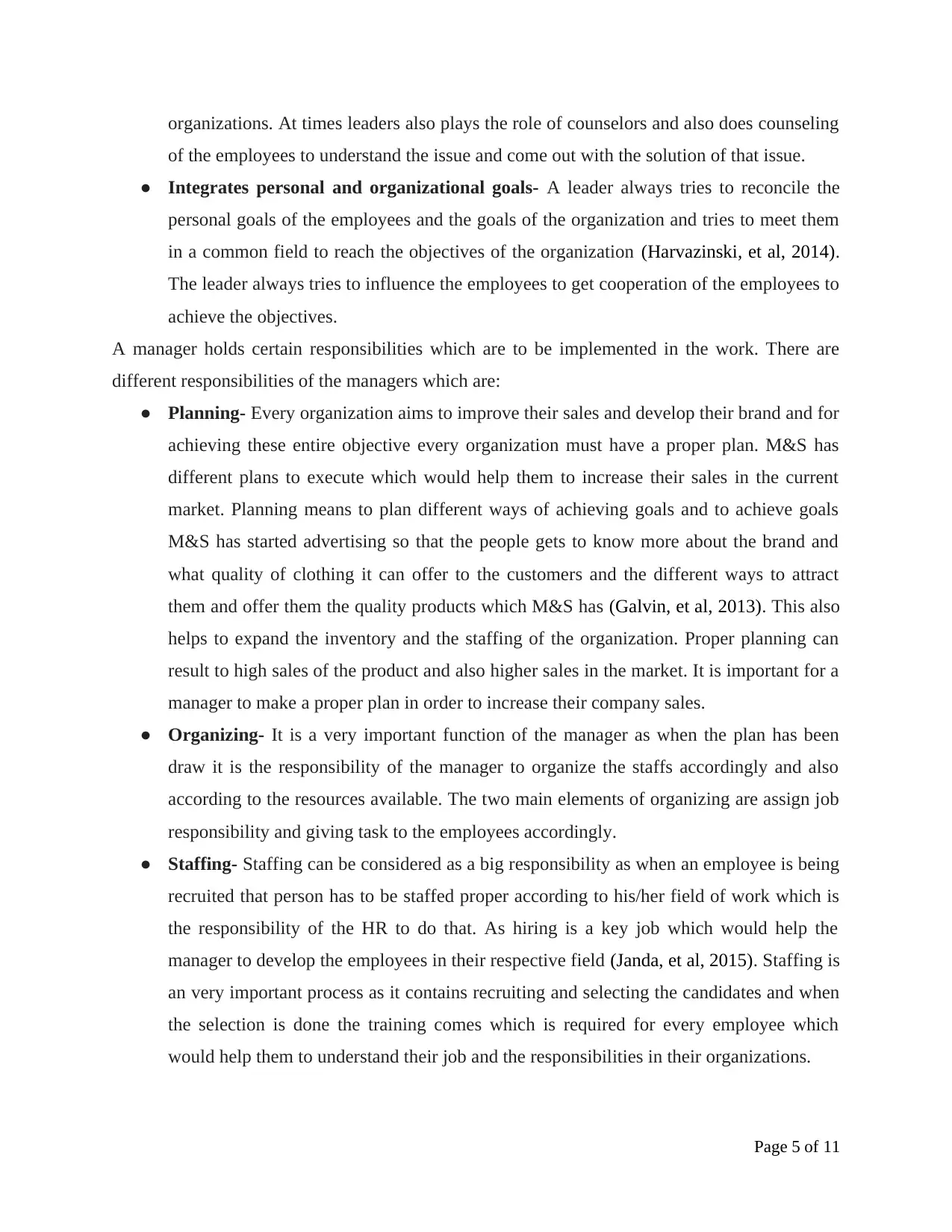
organizations. At times leaders also plays the role of counselors and also does counseling
of the employees to understand the issue and come out with the solution of that issue.
● Integrates personal and organizational goals- A leader always tries to reconcile the
personal goals of the employees and the goals of the organization and tries to meet them
in a common field to reach the objectives of the organization (Harvazinski, et al, 2014).
The leader always tries to influence the employees to get cooperation of the employees to
achieve the objectives.
A manager holds certain responsibilities which are to be implemented in the work. There are
different responsibilities of the managers which are:
● Planning- Every organization aims to improve their sales and develop their brand and for
achieving these entire objective every organization must have a proper plan. M&S has
different plans to execute which would help them to increase their sales in the current
market. Planning means to plan different ways of achieving goals and to achieve goals
M&S has started advertising so that the people gets to know more about the brand and
what quality of clothing it can offer to the customers and the different ways to attract
them and offer them the quality products which M&S has (Galvin, et al, 2013). This also
helps to expand the inventory and the staffing of the organization. Proper planning can
result to high sales of the product and also higher sales in the market. It is important for a
manager to make a proper plan in order to increase their company sales.
● Organizing- It is a very important function of the manager as when the plan has been
draw it is the responsibility of the manager to organize the staffs accordingly and also
according to the resources available. The two main elements of organizing are assign job
responsibility and giving task to the employees accordingly.
● Staffing- Staffing can be considered as a big responsibility as when an employee is being
recruited that person has to be staffed proper according to his/her field of work which is
the responsibility of the HR to do that. As hiring is a key job which would help the
manager to develop the employees in their respective field (Janda, et al, 2015). Staffing is
an very important process as it contains recruiting and selecting the candidates and when
the selection is done the training comes which is required for every employee which
would help them to understand their job and the responsibilities in their organizations.
Page 5 of 11
of the employees to understand the issue and come out with the solution of that issue.
● Integrates personal and organizational goals- A leader always tries to reconcile the
personal goals of the employees and the goals of the organization and tries to meet them
in a common field to reach the objectives of the organization (Harvazinski, et al, 2014).
The leader always tries to influence the employees to get cooperation of the employees to
achieve the objectives.
A manager holds certain responsibilities which are to be implemented in the work. There are
different responsibilities of the managers which are:
● Planning- Every organization aims to improve their sales and develop their brand and for
achieving these entire objective every organization must have a proper plan. M&S has
different plans to execute which would help them to increase their sales in the current
market. Planning means to plan different ways of achieving goals and to achieve goals
M&S has started advertising so that the people gets to know more about the brand and
what quality of clothing it can offer to the customers and the different ways to attract
them and offer them the quality products which M&S has (Galvin, et al, 2013). This also
helps to expand the inventory and the staffing of the organization. Proper planning can
result to high sales of the product and also higher sales in the market. It is important for a
manager to make a proper plan in order to increase their company sales.
● Organizing- It is a very important function of the manager as when the plan has been
draw it is the responsibility of the manager to organize the staffs accordingly and also
according to the resources available. The two main elements of organizing are assign job
responsibility and giving task to the employees accordingly.
● Staffing- Staffing can be considered as a big responsibility as when an employee is being
recruited that person has to be staffed proper according to his/her field of work which is
the responsibility of the HR to do that. As hiring is a key job which would help the
manager to develop the employees in their respective field (Janda, et al, 2015). Staffing is
an very important process as it contains recruiting and selecting the candidates and when
the selection is done the training comes which is required for every employee which
would help them to understand their job and the responsibilities in their organizations.
Page 5 of 11
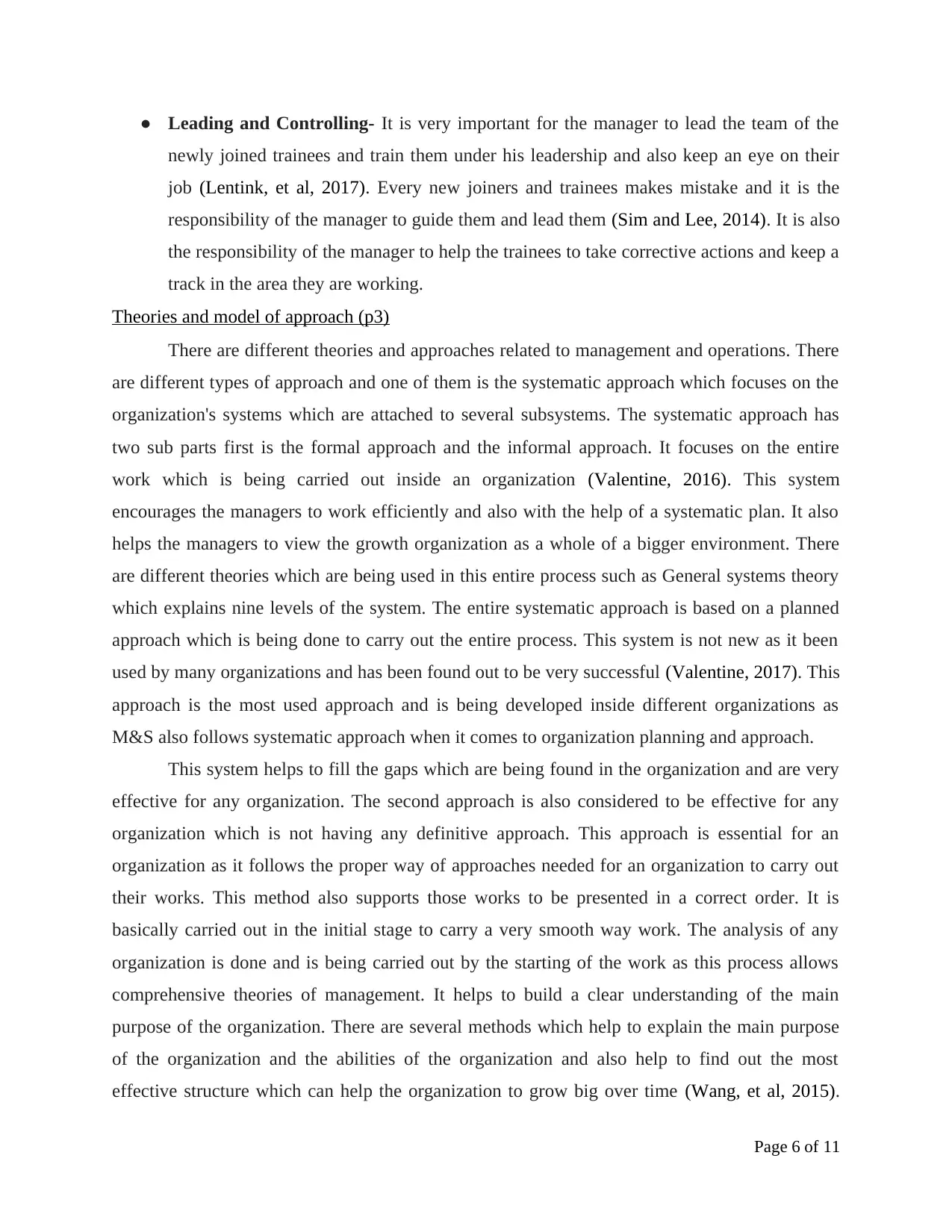
● Leading and Controlling- It is very important for the manager to lead the team of the
newly joined trainees and train them under his leadership and also keep an eye on their
job (Lentink, et al, 2017). Every new joiners and trainees makes mistake and it is the
responsibility of the manager to guide them and lead them (Sim and Lee, 2014). It is also
the responsibility of the manager to help the trainees to take corrective actions and keep a
track in the area they are working.
Theories and model of approach (p3)
There are different theories and approaches related to management and operations. There
are different types of approach and one of them is the systematic approach which focuses on the
organization's systems which are attached to several subsystems. The systematic approach has
two sub parts first is the formal approach and the informal approach. It focuses on the entire
work which is being carried out inside an organization (Valentine, 2016). This system
encourages the managers to work efficiently and also with the help of a systematic plan. It also
helps the managers to view the growth organization as a whole of a bigger environment. There
are different theories which are being used in this entire process such as General systems theory
which explains nine levels of the system. The entire systematic approach is based on a planned
approach which is being done to carry out the entire process. This system is not new as it been
used by many organizations and has been found out to be very successful (Valentine, 2017). This
approach is the most used approach and is being developed inside different organizations as
M&S also follows systematic approach when it comes to organization planning and approach.
This system helps to fill the gaps which are being found in the organization and are very
effective for any organization. The second approach is also considered to be effective for any
organization which is not having any definitive approach. This approach is essential for an
organization as it follows the proper way of approaches needed for an organization to carry out
their works. This method also supports those works to be presented in a correct order. It is
basically carried out in the initial stage to carry a very smooth way work. The analysis of any
organization is done and is being carried out by the starting of the work as this process allows
comprehensive theories of management. It helps to build a clear understanding of the main
purpose of the organization. There are several methods which help to explain the main purpose
of the organization and the abilities of the organization and also help to find out the most
effective structure which can help the organization to grow big over time (Wang, et al, 2015).
Page 6 of 11
newly joined trainees and train them under his leadership and also keep an eye on their
job (Lentink, et al, 2017). Every new joiners and trainees makes mistake and it is the
responsibility of the manager to guide them and lead them (Sim and Lee, 2014). It is also
the responsibility of the manager to help the trainees to take corrective actions and keep a
track in the area they are working.
Theories and model of approach (p3)
There are different theories and approaches related to management and operations. There
are different types of approach and one of them is the systematic approach which focuses on the
organization's systems which are attached to several subsystems. The systematic approach has
two sub parts first is the formal approach and the informal approach. It focuses on the entire
work which is being carried out inside an organization (Valentine, 2016). This system
encourages the managers to work efficiently and also with the help of a systematic plan. It also
helps the managers to view the growth organization as a whole of a bigger environment. There
are different theories which are being used in this entire process such as General systems theory
which explains nine levels of the system. The entire systematic approach is based on a planned
approach which is being done to carry out the entire process. This system is not new as it been
used by many organizations and has been found out to be very successful (Valentine, 2017). This
approach is the most used approach and is being developed inside different organizations as
M&S also follows systematic approach when it comes to organization planning and approach.
This system helps to fill the gaps which are being found in the organization and are very
effective for any organization. The second approach is also considered to be effective for any
organization which is not having any definitive approach. This approach is essential for an
organization as it follows the proper way of approaches needed for an organization to carry out
their works. This method also supports those works to be presented in a correct order. It is
basically carried out in the initial stage to carry a very smooth way work. The analysis of any
organization is done and is being carried out by the starting of the work as this process allows
comprehensive theories of management. It helps to build a clear understanding of the main
purpose of the organization. There are several methods which help to explain the main purpose
of the organization and the abilities of the organization and also help to find out the most
effective structure which can help the organization to grow big over time (Wang, et al, 2015).
Page 6 of 11
⊘ This is a preview!⊘
Do you want full access?
Subscribe today to unlock all pages.

Trusted by 1+ million students worldwide
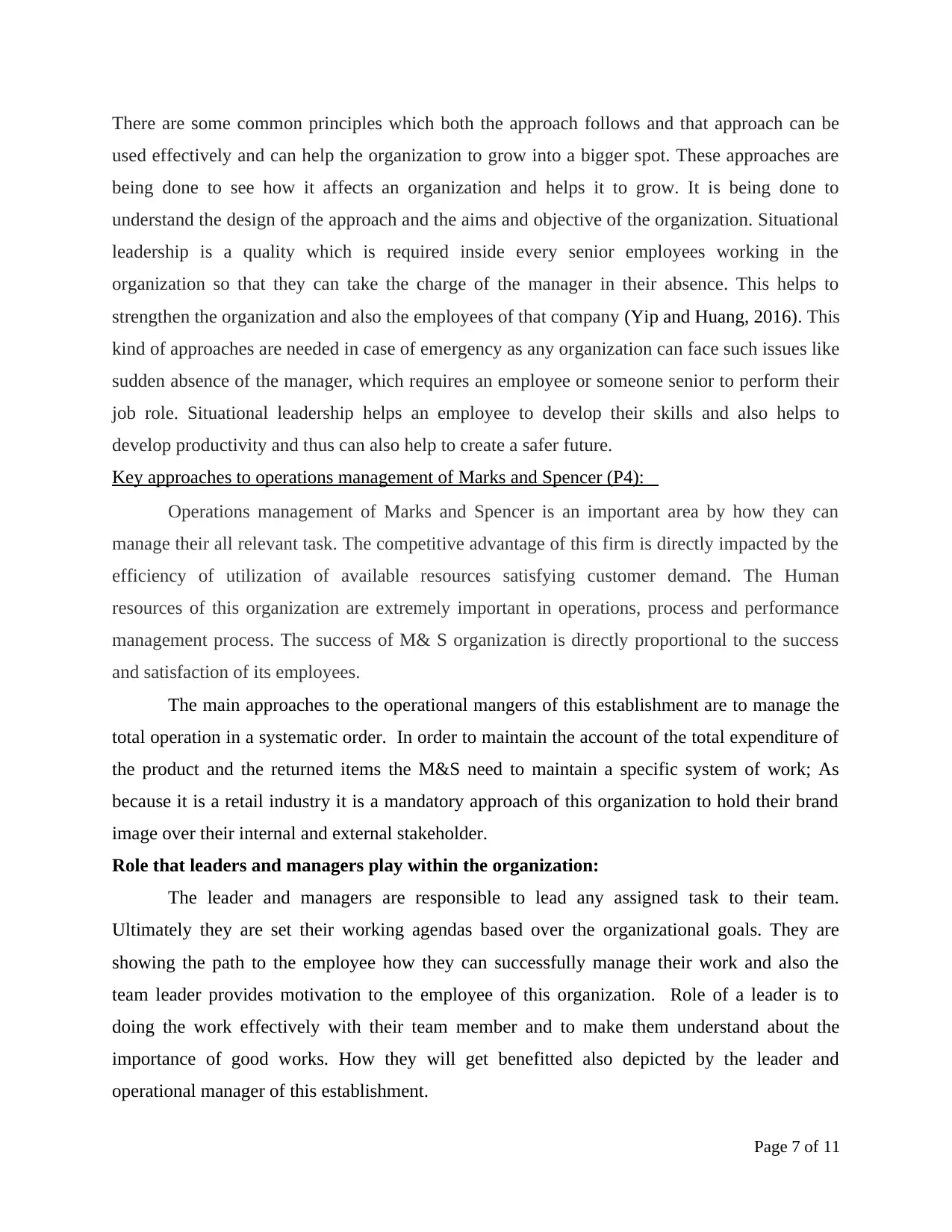
There are some common principles which both the approach follows and that approach can be
used effectively and can help the organization to grow into a bigger spot. These approaches are
being done to see how it affects an organization and helps it to grow. It is being done to
understand the design of the approach and the aims and objective of the organization. Situational
leadership is a quality which is required inside every senior employees working in the
organization so that they can take the charge of the manager in their absence. This helps to
strengthen the organization and also the employees of that company (Yip and Huang, 2016). This
kind of approaches are needed in case of emergency as any organization can face such issues like
sudden absence of the manager, which requires an employee or someone senior to perform their
job role. Situational leadership helps an employee to develop their skills and also helps to
develop productivity and thus can also help to create a safer future.
Key approaches to operations management of Marks and Spencer (P4):
Operations management of Marks and Spencer is an important area by how they can
manage their all relevant task. The competitive advantage of this firm is directly impacted by the
efficiency of utilization of available resources satisfying customer demand. The Human
resources of this organization are extremely important in operations, process and performance
management process. The success of M& S organization is directly proportional to the success
and satisfaction of its employees.
The main approaches to the operational mangers of this establishment are to manage the
total operation in a systematic order. In order to maintain the account of the total expenditure of
the product and the returned items the M&S need to maintain a specific system of work; As
because it is a retail industry it is a mandatory approach of this organization to hold their brand
image over their internal and external stakeholder.
Role that leaders and managers play within the organization:
The leader and managers are responsible to lead any assigned task to their team.
Ultimately they are set their working agendas based over the organizational goals. They are
showing the path to the employee how they can successfully manage their work and also the
team leader provides motivation to the employee of this organization. Role of a leader is to
doing the work effectively with their team member and to make them understand about the
importance of good works. How they will get benefitted also depicted by the leader and
operational manager of this establishment.
Page 7 of 11
used effectively and can help the organization to grow into a bigger spot. These approaches are
being done to see how it affects an organization and helps it to grow. It is being done to
understand the design of the approach and the aims and objective of the organization. Situational
leadership is a quality which is required inside every senior employees working in the
organization so that they can take the charge of the manager in their absence. This helps to
strengthen the organization and also the employees of that company (Yip and Huang, 2016). This
kind of approaches are needed in case of emergency as any organization can face such issues like
sudden absence of the manager, which requires an employee or someone senior to perform their
job role. Situational leadership helps an employee to develop their skills and also helps to
develop productivity and thus can also help to create a safer future.
Key approaches to operations management of Marks and Spencer (P4):
Operations management of Marks and Spencer is an important area by how they can
manage their all relevant task. The competitive advantage of this firm is directly impacted by the
efficiency of utilization of available resources satisfying customer demand. The Human
resources of this organization are extremely important in operations, process and performance
management process. The success of M& S organization is directly proportional to the success
and satisfaction of its employees.
The main approaches to the operational mangers of this establishment are to manage the
total operation in a systematic order. In order to maintain the account of the total expenditure of
the product and the returned items the M&S need to maintain a specific system of work; As
because it is a retail industry it is a mandatory approach of this organization to hold their brand
image over their internal and external stakeholder.
Role that leaders and managers play within the organization:
The leader and managers are responsible to lead any assigned task to their team.
Ultimately they are set their working agendas based over the organizational goals. They are
showing the path to the employee how they can successfully manage their work and also the
team leader provides motivation to the employee of this organization. Role of a leader is to
doing the work effectively with their team member and to make them understand about the
importance of good works. How they will get benefitted also depicted by the leader and
operational manager of this establishment.
Page 7 of 11
Paraphrase This Document
Need a fresh take? Get an instant paraphrase of this document with our AI Paraphraser
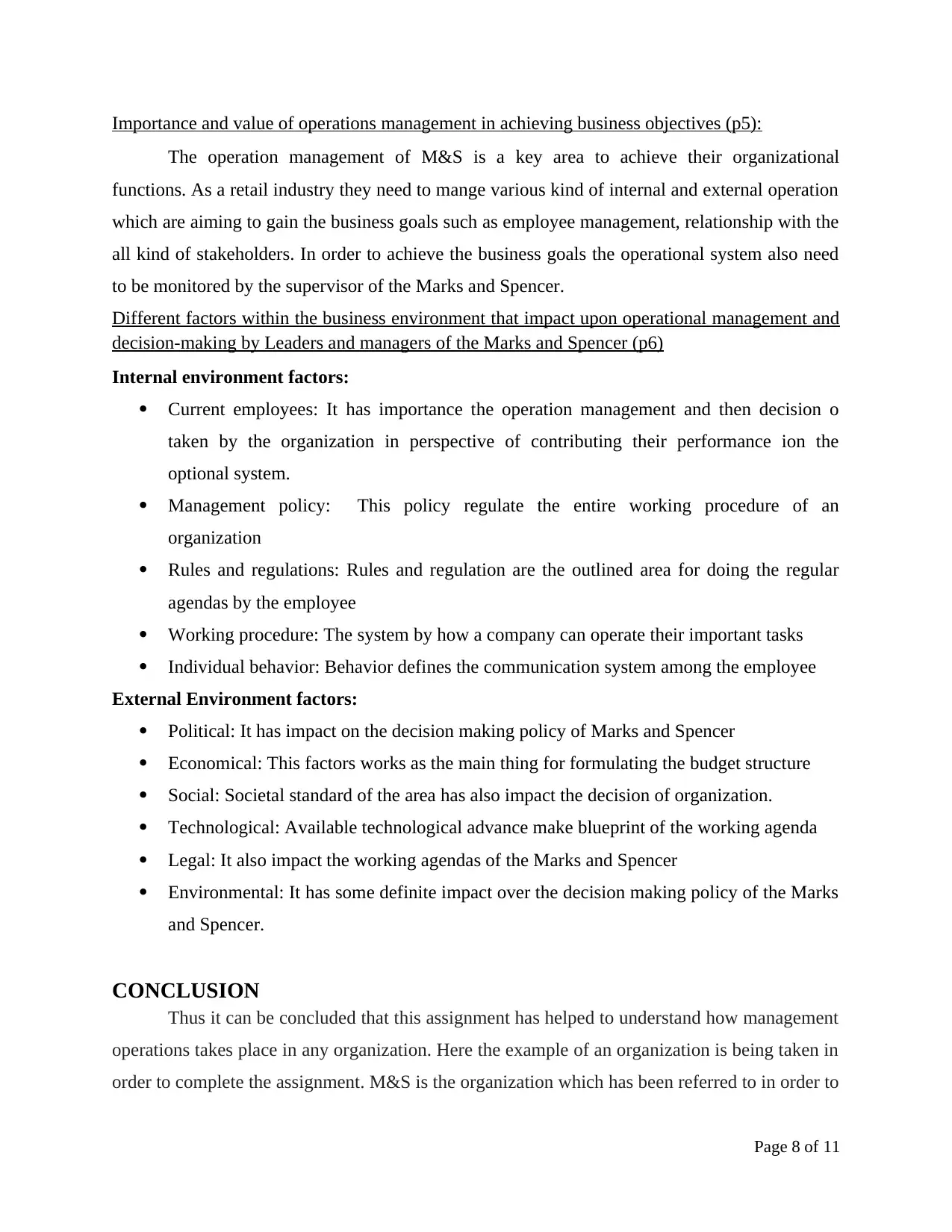
Importance and value of operations management in achieving business objectives (p5):
The operation management of M&S is a key area to achieve their organizational
functions. As a retail industry they need to mange various kind of internal and external operation
which are aiming to gain the business goals such as employee management, relationship with the
all kind of stakeholders. In order to achieve the business goals the operational system also need
to be monitored by the supervisor of the Marks and Spencer.
Different factors within the business environment that impact upon operational management and
decision-making by Leaders and managers of the Marks and Spencer (p6)
Internal environment factors:
Current employees: It has importance the operation management and then decision o
taken by the organization in perspective of contributing their performance ion the
optional system.
Management policy: This policy regulate the entire working procedure of an
organization
Rules and regulations: Rules and regulation are the outlined area for doing the regular
agendas by the employee
Working procedure: The system by how a company can operate their important tasks
Individual behavior: Behavior defines the communication system among the employee
External Environment factors:
Political: It has impact on the decision making policy of Marks and Spencer
Economical: This factors works as the main thing for formulating the budget structure
Social: Societal standard of the area has also impact the decision of organization.
Technological: Available technological advance make blueprint of the working agenda
Legal: It also impact the working agendas of the Marks and Spencer
Environmental: It has some definite impact over the decision making policy of the Marks
and Spencer.
CONCLUSION
Thus it can be concluded that this assignment has helped to understand how management
operations takes place in any organization. Here the example of an organization is being taken in
order to complete the assignment. M&S is the organization which has been referred to in order to
Page 8 of 11
The operation management of M&S is a key area to achieve their organizational
functions. As a retail industry they need to mange various kind of internal and external operation
which are aiming to gain the business goals such as employee management, relationship with the
all kind of stakeholders. In order to achieve the business goals the operational system also need
to be monitored by the supervisor of the Marks and Spencer.
Different factors within the business environment that impact upon operational management and
decision-making by Leaders and managers of the Marks and Spencer (p6)
Internal environment factors:
Current employees: It has importance the operation management and then decision o
taken by the organization in perspective of contributing their performance ion the
optional system.
Management policy: This policy regulate the entire working procedure of an
organization
Rules and regulations: Rules and regulation are the outlined area for doing the regular
agendas by the employee
Working procedure: The system by how a company can operate their important tasks
Individual behavior: Behavior defines the communication system among the employee
External Environment factors:
Political: It has impact on the decision making policy of Marks and Spencer
Economical: This factors works as the main thing for formulating the budget structure
Social: Societal standard of the area has also impact the decision of organization.
Technological: Available technological advance make blueprint of the working agenda
Legal: It also impact the working agendas of the Marks and Spencer
Environmental: It has some definite impact over the decision making policy of the Marks
and Spencer.
CONCLUSION
Thus it can be concluded that this assignment has helped to understand how management
operations takes place in any organization. Here the example of an organization is being taken in
order to complete the assignment. M&S is the organization which has been referred to in order to
Page 8 of 11
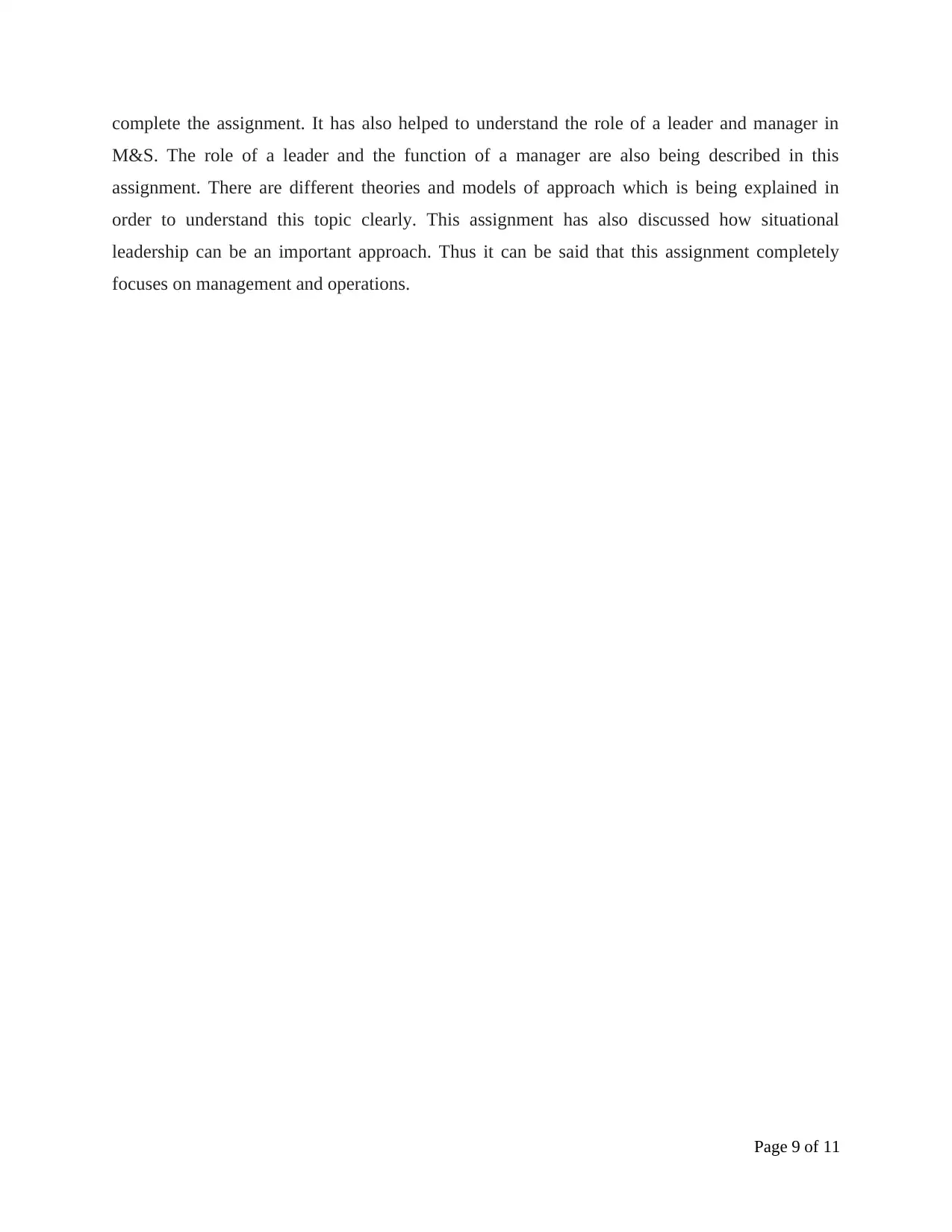
complete the assignment. It has also helped to understand the role of a leader and manager in
M&S. The role of a leader and the function of a manager are also being described in this
assignment. There are different theories and models of approach which is being explained in
order to understand this topic clearly. This assignment has also discussed how situational
leadership can be an important approach. Thus it can be said that this assignment completely
focuses on management and operations.
Page 9 of 11
M&S. The role of a leader and the function of a manager are also being described in this
assignment. There are different theories and models of approach which is being explained in
order to understand this topic clearly. This assignment has also discussed how situational
leadership can be an important approach. Thus it can be said that this assignment completely
focuses on management and operations.
Page 9 of 11
⊘ This is a preview!⊘
Do you want full access?
Subscribe today to unlock all pages.

Trusted by 1+ million students worldwide
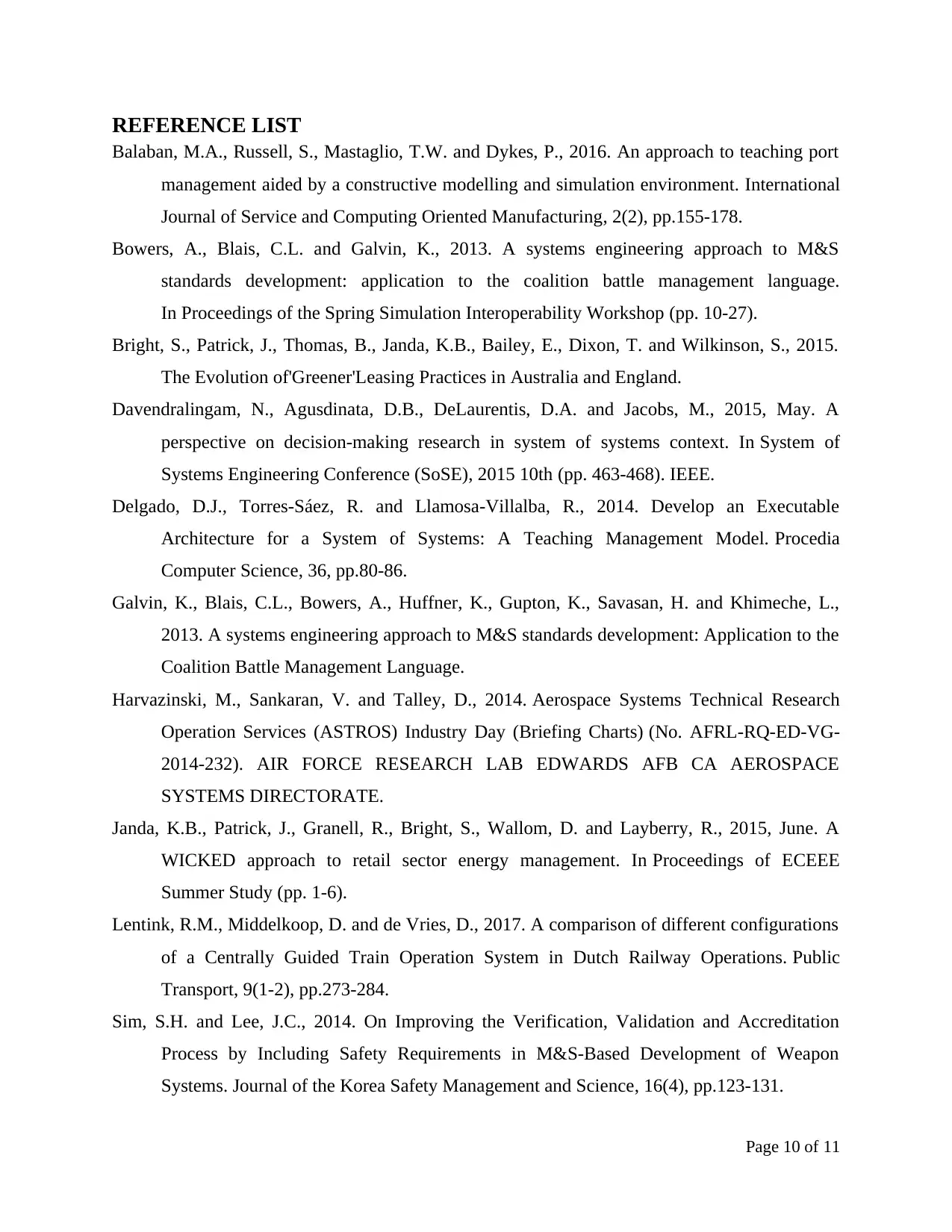
REFERENCE LIST
Balaban, M.A., Russell, S., Mastaglio, T.W. and Dykes, P., 2016. An approach to teaching port
management aided by a constructive modelling and simulation environment. International
Journal of Service and Computing Oriented Manufacturing, 2(2), pp.155-178.
Bowers, A., Blais, C.L. and Galvin, K., 2013. A systems engineering approach to M&S
standards development: application to the coalition battle management language.
In Proceedings of the Spring Simulation Interoperability Workshop (pp. 10-27).
Bright, S., Patrick, J., Thomas, B., Janda, K.B., Bailey, E., Dixon, T. and Wilkinson, S., 2015.
The Evolution of'Greener'Leasing Practices in Australia and England.
Davendralingam, N., Agusdinata, D.B., DeLaurentis, D.A. and Jacobs, M., 2015, May. A
perspective on decision-making research in system of systems context. In System of
Systems Engineering Conference (SoSE), 2015 10th (pp. 463-468). IEEE.
Delgado, D.J., Torres-Sáez, R. and Llamosa-Villalba, R., 2014. Develop an Executable
Architecture for a System of Systems: A Teaching Management Model. Procedia
Computer Science, 36, pp.80-86.
Galvin, K., Blais, C.L., Bowers, A., Huffner, K., Gupton, K., Savasan, H. and Khimeche, L.,
2013. A systems engineering approach to M&S standards development: Application to the
Coalition Battle Management Language.
Harvazinski, M., Sankaran, V. and Talley, D., 2014. Aerospace Systems Technical Research
Operation Services (ASTROS) Industry Day (Briefing Charts) (No. AFRL-RQ-ED-VG-
2014-232). AIR FORCE RESEARCH LAB EDWARDS AFB CA AEROSPACE
SYSTEMS DIRECTORATE.
Janda, K.B., Patrick, J., Granell, R., Bright, S., Wallom, D. and Layberry, R., 2015, June. A
WICKED approach to retail sector energy management. In Proceedings of ECEEE
Summer Study (pp. 1-6).
Lentink, R.M., Middelkoop, D. and de Vries, D., 2017. A comparison of different configurations
of a Centrally Guided Train Operation System in Dutch Railway Operations. Public
Transport, 9(1-2), pp.273-284.
Sim, S.H. and Lee, J.C., 2014. On Improving the Verification, Validation and Accreditation
Process by Including Safety Requirements in M&S-Based Development of Weapon
Systems. Journal of the Korea Safety Management and Science, 16(4), pp.123-131.
Page 10 of 11
Balaban, M.A., Russell, S., Mastaglio, T.W. and Dykes, P., 2016. An approach to teaching port
management aided by a constructive modelling and simulation environment. International
Journal of Service and Computing Oriented Manufacturing, 2(2), pp.155-178.
Bowers, A., Blais, C.L. and Galvin, K., 2013. A systems engineering approach to M&S
standards development: application to the coalition battle management language.
In Proceedings of the Spring Simulation Interoperability Workshop (pp. 10-27).
Bright, S., Patrick, J., Thomas, B., Janda, K.B., Bailey, E., Dixon, T. and Wilkinson, S., 2015.
The Evolution of'Greener'Leasing Practices in Australia and England.
Davendralingam, N., Agusdinata, D.B., DeLaurentis, D.A. and Jacobs, M., 2015, May. A
perspective on decision-making research in system of systems context. In System of
Systems Engineering Conference (SoSE), 2015 10th (pp. 463-468). IEEE.
Delgado, D.J., Torres-Sáez, R. and Llamosa-Villalba, R., 2014. Develop an Executable
Architecture for a System of Systems: A Teaching Management Model. Procedia
Computer Science, 36, pp.80-86.
Galvin, K., Blais, C.L., Bowers, A., Huffner, K., Gupton, K., Savasan, H. and Khimeche, L.,
2013. A systems engineering approach to M&S standards development: Application to the
Coalition Battle Management Language.
Harvazinski, M., Sankaran, V. and Talley, D., 2014. Aerospace Systems Technical Research
Operation Services (ASTROS) Industry Day (Briefing Charts) (No. AFRL-RQ-ED-VG-
2014-232). AIR FORCE RESEARCH LAB EDWARDS AFB CA AEROSPACE
SYSTEMS DIRECTORATE.
Janda, K.B., Patrick, J., Granell, R., Bright, S., Wallom, D. and Layberry, R., 2015, June. A
WICKED approach to retail sector energy management. In Proceedings of ECEEE
Summer Study (pp. 1-6).
Lentink, R.M., Middelkoop, D. and de Vries, D., 2017. A comparison of different configurations
of a Centrally Guided Train Operation System in Dutch Railway Operations. Public
Transport, 9(1-2), pp.273-284.
Sim, S.H. and Lee, J.C., 2014. On Improving the Verification, Validation and Accreditation
Process by Including Safety Requirements in M&S-Based Development of Weapon
Systems. Journal of the Korea Safety Management and Science, 16(4), pp.123-131.
Page 10 of 11
Paraphrase This Document
Need a fresh take? Get an instant paraphrase of this document with our AI Paraphraser
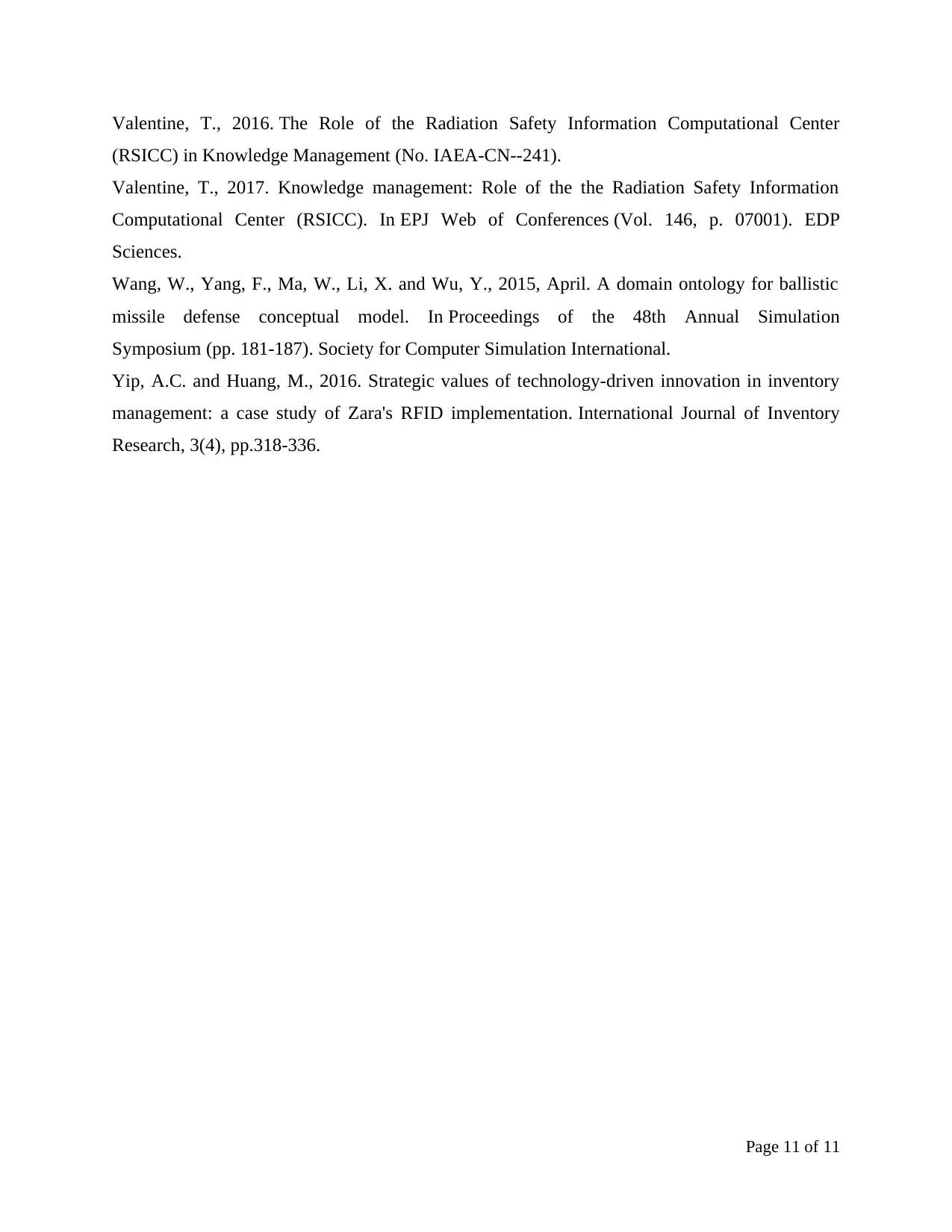
Valentine, T., 2016. The Role of the Radiation Safety Information Computational Center
(RSICC) in Knowledge Management (No. IAEA-CN--241).
Valentine, T., 2017. Knowledge management: Role of the the Radiation Safety Information
Computational Center (RSICC). In EPJ Web of Conferences (Vol. 146, p. 07001). EDP
Sciences.
Wang, W., Yang, F., Ma, W., Li, X. and Wu, Y., 2015, April. A domain ontology for ballistic
missile defense conceptual model. In Proceedings of the 48th Annual Simulation
Symposium (pp. 181-187). Society for Computer Simulation International.
Yip, A.C. and Huang, M., 2016. Strategic values of technology-driven innovation in inventory
management: a case study of Zara's RFID implementation. International Journal of Inventory
Research, 3(4), pp.318-336.
Page 11 of 11
(RSICC) in Knowledge Management (No. IAEA-CN--241).
Valentine, T., 2017. Knowledge management: Role of the the Radiation Safety Information
Computational Center (RSICC). In EPJ Web of Conferences (Vol. 146, p. 07001). EDP
Sciences.
Wang, W., Yang, F., Ma, W., Li, X. and Wu, Y., 2015, April. A domain ontology for ballistic
missile defense conceptual model. In Proceedings of the 48th Annual Simulation
Symposium (pp. 181-187). Society for Computer Simulation International.
Yip, A.C. and Huang, M., 2016. Strategic values of technology-driven innovation in inventory
management: a case study of Zara's RFID implementation. International Journal of Inventory
Research, 3(4), pp.318-336.
Page 11 of 11
1 out of 11
Related Documents
Your All-in-One AI-Powered Toolkit for Academic Success.
+13062052269
info@desklib.com
Available 24*7 on WhatsApp / Email
![[object Object]](/_next/static/media/star-bottom.7253800d.svg)
Unlock your academic potential
Copyright © 2020–2025 A2Z Services. All Rights Reserved. Developed and managed by ZUCOL.




